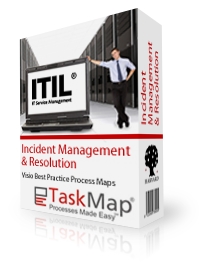ITIL stands for Information Technology Infrastructure Library. ITIL was originally created by a UK government agency (the CCTA) and is now being adopted worldwide as the de facto standard for best practices in the provision of IT Service.
All of the ITIL process maps created in this set are based on Microsoft ITIL extension documents provided from the Microsoft Operations Foundation and the ITIL standards 2.0 and 3.0 documents. These documents are long and can be difficult to understand. Our goal in creating the process maps for the ITIL documents was to develop a systematic approach to implementing ITIL best practices. By instigating these effective and repeatable best practices, we can monitor and improve upon quality, training and technology transfer, compliance and efficiency.

What’s Included
-
Complete set of pre-populated ITIL Incident Management and Resolution Process Maps in PDF format
-
14 pages of ITIL Incident Management and Resolution processes defined with all tasks, roles, guidelines resources and relationships clearly defined
-
Processes defined (click for more details):
Details
-
Incident Management Dashboard: Provides a high-level view of each major process. Includes hyperlinks to each of the following processes:
-
Obtain Service Request Details: All aspects of an ITIL compliant environment including: Identification of record type, creating new request and procedures, cross-checking initiators with customer base, designating unique reference identifiers, reviewing original event and scheduling customer updates. (Includes links all relevant best practice details)
-
Classification: All relevant tasks for an effective classification process including: Running diagnostic scripts, referencing of incidents to the Customer Management Database, assigning prioritization, searching the database for known error records and major incident consideration.
-
Service Desk Resolves Incident: ITIL guided process that includes optional paths show incident linking with records, matching symptoms to knowledge bases, updating error report database, recording details of resolution, advising configuration manager of updated records and updating the Customer Management Database.
-
No Known Resolution: Every task for release preparation is included: Assembling resources, communications plan for release to users, training sub process for supporting staff, scheduling support for the deployment and completing a readiness review
-
Major Incident Determination: Log incident with high priority, notifying resolver group, confirmation of scope and impact, flaggingsuspected major incidents to incident manager, initiating major incident procedure, contacting all involved parties and determine whether to invoke major incident procedures.
-
Major Incident: Notification of interested parties, gathering information, confirm situation, form restoration team, develop communications plan, hold initial planning meeting, hold management team meeting, issue update statements, allocate additional resources, authorize travel expenses, follow standard incident procedure, hold restoration review meeting, decide whether to involve service continuity plan, release unnecessary members of restoration team from incident assignment and recall team.
-
Investigation: Notification of interested parties, gathering information, confirm situation, form restoration team, develop communications plan, hold initial planning meeting, hold management team meeting, issue update statements, allocate additional resources, authorize travel expenses, follow standard incident procedure, hold restoration review meeting, decide whether to involve service continuity plan, release unnecessary members of restoration team from incident assignment and recall team.
-
Resolver Group Assignment: Assign incident to resolver group, assign incident to resovler group team member, maintain incident record.
-
Diagnosis Phase: Determine exact error message or event IDs produced, confirm actions leading up to incident, confirm scope of incident, attempt to recreate incident and identify why incident is occurring.
-
Troubleshooting Complex Incidents: Assign incident to resolver group, assign incident to resovler group team member, maintain incident record.
-
Resolution and Recovery: Identify and test workaround/solution, notify Incident Management with solution details, interface with change management process to implement changes, confirm resolution actions and carry out recovery actions.
-
Closure: Update incident record status to resolved, pass records to service desk team, pass records to service desk team, confirm with initiator that incident was resolved, record incident and resolution details, contact resolver group to obtain update, categorize incident closure, investigate and create new category if needed and close incident record.
|
|
|
After you have paid for this product, you can download it right away by simply clicking on the "Download Now" Button that appears on your receipt page!





